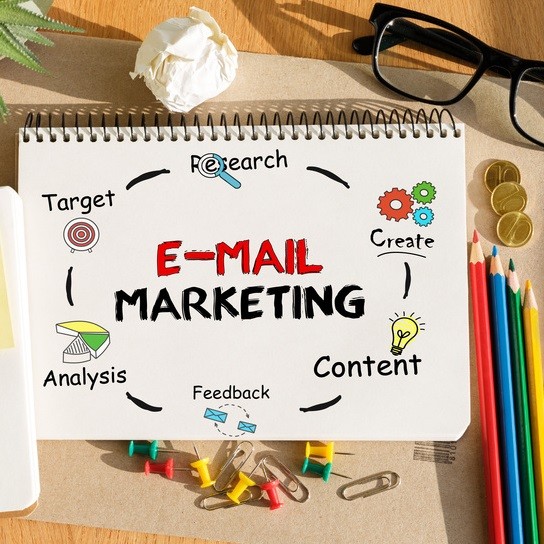JoomConnect Blog
Making Email Marketing Work for Your Business, Part 1
Email marketing isn’t easy. You have to spend the time and effort to make sure you have solid copy, are following all the rules and regulations of email marketing, complying with the rules set forth by companies like Mailchimp and Constant Contact, adding images and video that actually enhance your copy, and making sure you have the perfect subject line to make your audience even open your email. That’s a lot and we get that, but there are ways to track and test what you’re doing to make email marketing work for your company. In this 2 part blog, we’re breaking down 6 items you can test pretty easily in your emails, with some advice to help you along the way.
1. Say What You Mean, and Be YOU!
 What you say, how you say it and how much you say actually matter quite a bit. Your subject and from lines are the first things your audience sees, so you need them to be attention-getting and personal. Think of this part like being at a trade show. You want people to talk to you so you can show them what you have to offer, so you dress professionally, remain approachable and always start with an introduction. You want your emails to basically replicate that process. Be personal. People want to know that you know who they are, and appreciate them and their business - throw in people’s names in the subject lines. At the very least, use words like “you” or “your” to give your subject lines a slight personalized touch.
What you say, how you say it and how much you say actually matter quite a bit. Your subject and from lines are the first things your audience sees, so you need them to be attention-getting and personal. Think of this part like being at a trade show. You want people to talk to you so you can show them what you have to offer, so you dress professionally, remain approachable and always start with an introduction. You want your emails to basically replicate that process. Be personal. People want to know that you know who they are, and appreciate them and their business - throw in people’s names in the subject lines. At the very least, use words like “you” or “your” to give your subject lines a slight personalized touch.
While we’re on the topic of personalization, make sure your audience knows who the email is coming from. Avoid sending emails from “MarketingTeam@mycompany” - this lacks any personalization and makes your reader aware that this email is an email blast, probably sent to 100 people and they’ll probably be more likely to delete it. Send your emails from an actual person in your company, even if the replies go back to the whole marketing team, at least your reader will feel like the email was intended just for them.
What you say is incredibly important, so choose your words wisely. People are going to decide whether that email you just sent is worth their time when they read your subject line. Make sure you tell them what the email is about. “The Weather at the North Pole is Currently…” probably isn’t going to get them to check out the new service you have or even get them to open the email - I know I wouldn’t. Puns, alliteration and rhymes are all fun ways to build subject lines, just be sure that you’re clear and concise. Say something like, “Sally, Summer’s Almost Here, Is Your Marketing in Gear? - Check Out Our New Service!” - personal, fun and to the point.
2. Time is Important, but it’s Not Universal!
Believe it or not, when you send an email is also important to the success of your email marketing. Various studies have been conducted to decipher what days and time are the best for sending emails. Some of these studies found the best day and time to be Tuesdays at 10am, some say 6am Monday, some say Saturday at noon and some say Thursday between 7 and 11pm.
 What does this mean? It’s different for everyone and probably, every list. The BEST thing you can do is testing your own audience. Run a few test groups on your own. Pick some days and test times throughout those days. Your audience might mirror one of these studies, but it might not. It’s important to make sure you’re not missing your target, so test, test, test!
What does this mean? It’s different for everyone and probably, every list. The BEST thing you can do is testing your own audience. Run a few test groups on your own. Pick some days and test times throughout those days. Your audience might mirror one of these studies, but it might not. It’s important to make sure you’re not missing your target, so test, test, test!
You can definitely run your own test campaigns, but you might not have time for all that. Some email marketing platforms have options like Send Time Optimization from MailChimp, where they take the guess work out of trying to figure the best time to send emails for their paid accounts. It will look at your lists, determine the best time to send and send the email at the best time.
3. How Much do You Really Have to Say?
Shorter emails tend to be best, but the actual length is most dependant on your audience because everyone’s definition of “shorter” is just a little bit different. The key with this is to focus on your subject. Don’t go off on tangents and be concise when you’re writing. Best practice: Write like you’re talking to someone face-to-face. That way you keep the language and the feel conversational - and keep the personal feel running throughout your email.
Also, too much copy in an email is actually a red flag for spam filters. So it’s important to test and see what length of emails provide the best results for you and your company.
Think about how much time you spend on emails each day. If we’re being honest with one another, we don’t really read all of our emails. If fact, we typically skim them to see if there’s anything that stands out - make your email stand out by not being too long, keep them personal and to the point, and use links that send me to your site to learn about your offer. Learn more about that last one and the other items to help you test email marketing for your company in Part 2 of this blog. We completely understand that email marketing takes a lot of work. If you have questions about an email you’re writing or email marketing in general, reach out to one of our marketing pros!




Comments